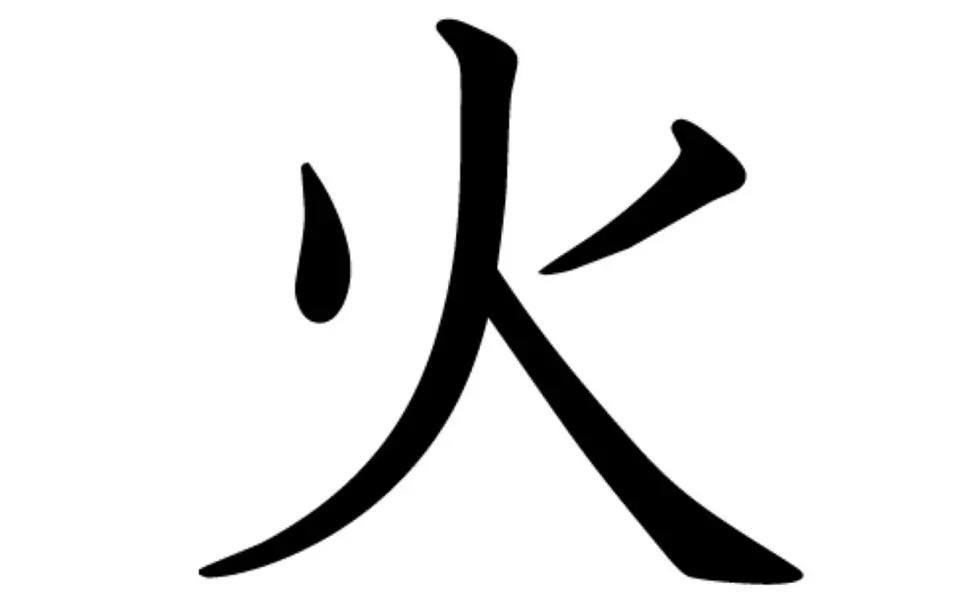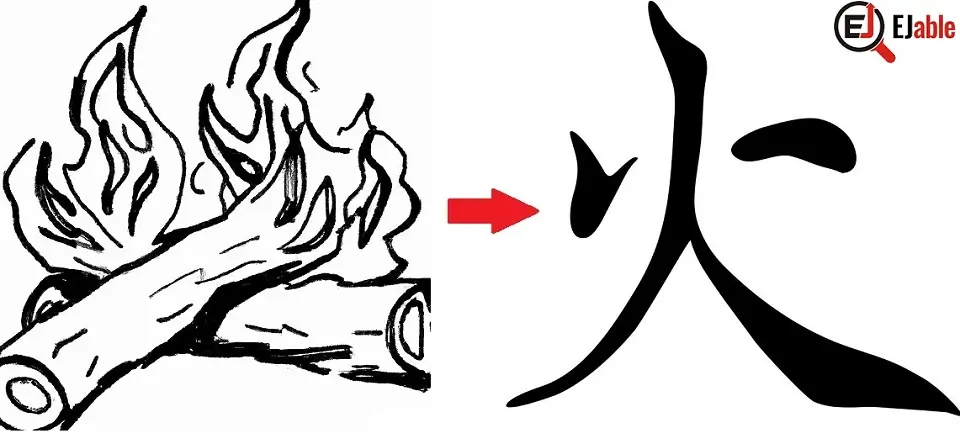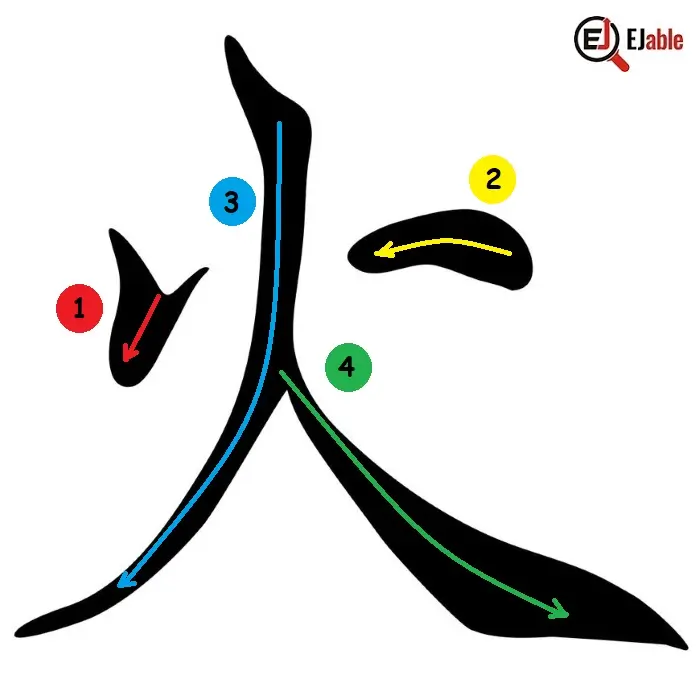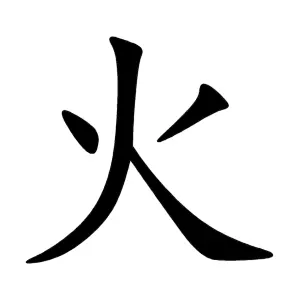Kanji for Fire: 火 (Hi)

The Japanese Kanji for “fire” is 火. The pronunciation of fire’s kanji is “ka” in on’yomi (Chinese reading), and fire in Japanese, i.e., in kun’yomi (Japanese reading), is “Hi.” Please note that the Kunyomi pronunciation of “Hi” is like the word “He” in English.
Fire’s Kanji 火 is constructed with four strokes. It is part of the JLPT N5 syllabus (please check the list of JLPT N5 Kanji) and is taught in grade 1 in Japanese schools.
Origin of the Kanji 火
The earliest known examples of Chinese writing, found on oracle bones script and bronze vessels, show that the Kanji of Fire (火) originally depicted flames of a fire. The character gradually became stylized and abstracted over time, evolving into its modern form.
Mnemonic: How to Remember the Kanji 火 of Fire
The three long lines making an upside-down “Y” represent three firewood logs. The two short dashes can be considered flames and smoke. In this representation, the kanji of fire shows the object in the top view. (Note: To check the three different views of a 3-D object, please check the article about remembering Kanji.)
The beauty is that while fire’s Kanji tells us about its origin, the shape of the kanji also serves as a mnemonic. The following picture helps to understand the above visualization and helps you remember this kanji.

Explanation
The above picture can help to remember the Kanji of fire easily. It is better to visualize the fire as a side view as follows:
- The two lines on the bottom represent the flames or the firewood.
- The top and short lines on the side represent flames and smoke coming out of the fire.
Stroke Order for the Kanji 火
The following illustrations show the stroke order to write the kanji of fire (火):


Fire’s Symbolism and Cultural Significance
As in many others, fire is a powerful symbol in Japanese culture.
It represents energy, warmth, purification, and transformation. Fire’s dual nature as a life-sustaining and destructive force is deeply embedded in the human psyche and cultural narratives. In Shinto rituals, fire is often used for purification, symbolizing the burning away of impurities.
Fire Kanji as a Radical and Component
kanji for “fire,” 火 (hi), is frequently used as a radical in many other kanji characters. When used as a radical, it typically imparts meanings related to fire, heat, light, or energy. This radical is known as “ひへん” (hihen) in Japanese.
As explained in the article about Kanji radicals, the radical of fire’s kanji appears in two shapes: the original shape of the kanji and 灬.
Overall, Kanji 火 appears as a radical or as a component in 276 Kanji characters, including 19 Jōyō Kanji.
Examples of 火 as a radical
Following are some examples of kanji where 火 appears as a radical:
- 灯 (とう, you): Lamp, light.
- 災 (さい, sai or わざわ-い wazawa-i): Disaster, calamity
- 炎 (えん, en): Flame, blaze.
- 煮 (しゃ, sha): Boil, cook.
- 炊 (すい, sui): Cook (particularly rice).
- 炭 (たん, tan): Charcoal.
- 炒 (いためる, itameru): Stir fry.
- 焼 (やく, yaku): Bake, grill.
- 為 (い, i): Do, make.
- 烈 (れつ, retsu): Violent, fierce.
- 煩 (はん, han): Annoy, bother.
- 煙 (けむり, kemuri): Smoke.
- 照 (しょう, shou): Illuminate, shine.
- 熱 (ねつ, netsu): Heat, fever.
- 燃 (ねん, nen): Burn, ignite.
- 炉 (ろ, ro): Hearth, furnace.
These kanji illustrate how the fire radical is used to convey meanings related to fire, heat, and processes or actions involving these elements.
Fire in Japanese Language and Expressions
Fire in Japanese, i.e., 火, is used in various contexts, not just to describe fire itself but also in words that convey related concepts.
There are 272 Japanese words that begin with the Kanji 火, and it appears in 516 words.
Examples of Kanji 火 in Compounded Kanji Characters
Following are some compound words that use the “fire” (火):
- 火事 (かじ, kaji): Fire (as in a fire incident).
- 火山 (かざん, kazan): Volcano.
- 火曜日 (かようび, kayoubi): Tuesday (literally “fire day”).
- 花火 (はなび, hanabi): Fireworks.
- 消火器 (しょうかき, shoukaki): Fire extinguisher.
- 発火 (はっか, hakka): Ignition, combustion.
- 火力 (かりょく, karyoku): Firepower or thermal power.
- 火災 (かさい, kasai): Fire disaster, conflagration.
- 火炎 (かえん, kaen): Flame, blaze.
- 放火 (ほうか, houka): Arson.
- 点火 (てんか, tenka): Ignition.
- 火鉢 (ひばち, hibachi): Japanese brazier.
- 防火 (ぼうか, bouka): Fire prevention, fireproof.
- 火口 (かこう, kakou): Crater.
- 火種 (ひだね, hidane): Source of fire, ember.
These compound words showcase the diverse contexts in which the kanji 火 is used, from literal references to fire to more metaphorical uses, such as in the case of fireworks (花火).
Conclusion
The Kanji 火 represents fire in a straightforward yet profound way, reflecting its practical and symbolic importance. Fire has always been essential to human life, providing heat, light, and food and shaping the world around us. It also symbolizes power, transformation, and dynamic change.
Do check other Kanji characters on the page “How to Remember Kanji“.

A long-term ex-pat in Japan, Himanshu comes with an IT background in SAP consulting, IT Business Development, and then running the country operations of an IT consulting multinational. Himanshu is the co-founder and Managing Director of ReachExt K.K. and EJable.com. He is also an Advisory Board Member of a Silicon Valley AI/IoT startup.
